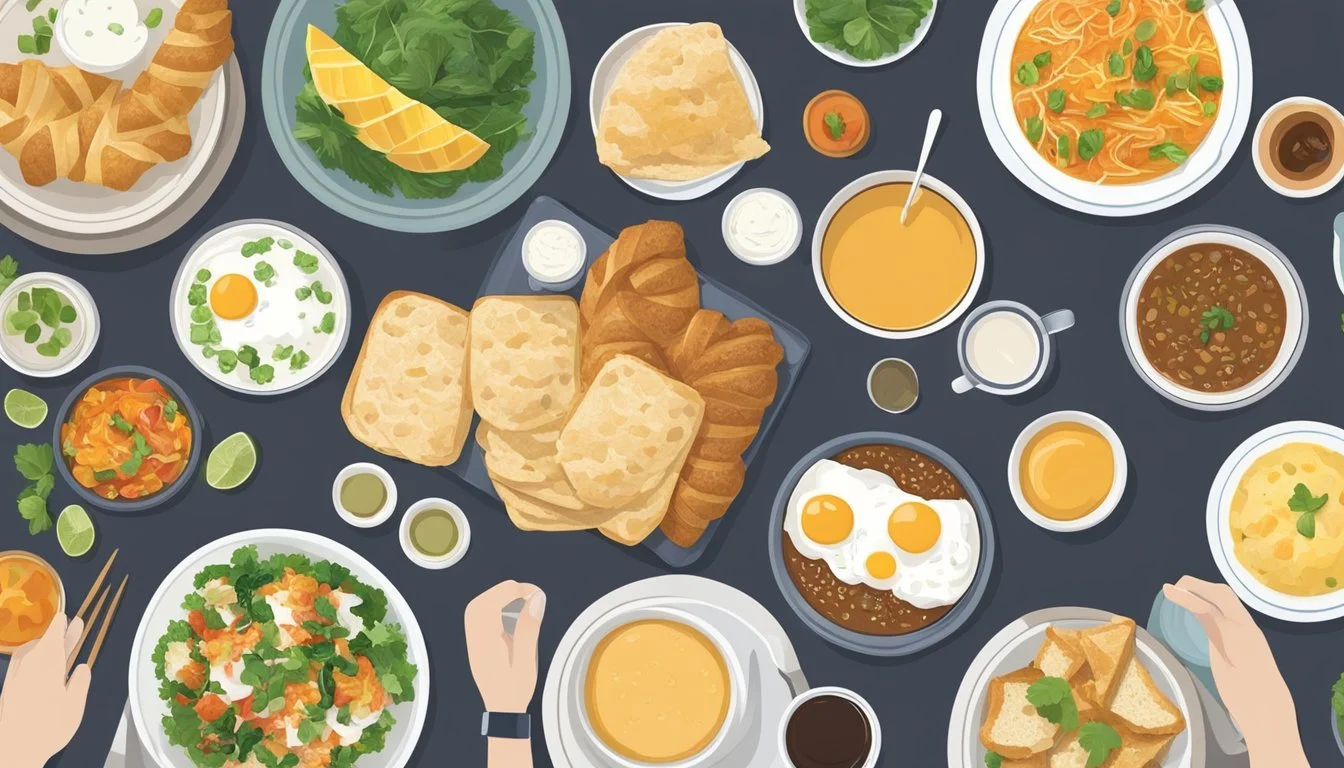10 Breakfast Foods from Around the World
A Global Morning Feast
Breakfast is a cherished ritual that varies remarkably across different cultures, offering unique insights into local traditions, ingredients, and culinary techniques. From hearty and savory dishes to light and sweet treats, every country has its own way of creating a perfect morning meal. Understanding these diverse breakfast customs not only satisfies the palate but also broadens one’s appreciation for global culinary practices.
Exploring breakfast foods from around the world showcases the incredible variety and creativity in morning meals. Each dish tells a story of its origin, reflecting history, climate, and the lifestyle of its people. This article highlights 10 exceptional breakfast dishes, providing a flavorful journey through different cultures and regions.
1) Tamago Kake Gohan (Japan)
Tamago Kake Gohan, often abbreviated as TKG, is a beloved breakfast dish in Japan. It consists of simple ingredients: a raw egg cracked over steaming hot rice. The egg is mixed vigorously into the rice, creating a frothy and fluffy texture.
Seasoning is key to enhancing the dish's flavors. Common additions include soy sauce, mirin, and sometimes a pinch of MSG or Hondashi. These seasonings are added to taste, allowing for a customized breakfast experience.
In Japan, there's significant cultural appreciation for TKG. It's frequently highlighted in manga, anime, and even dedicated festivals and symposiums. The dish’s simplicity and versatility make it a staple in Japanese households.
The traditional preparation method involves making a well in the hot rice before adding the egg. The rice's heat slightly cooks the egg, creating a creamy and comforting meal. Optional toppings can include nori (seaweed), green onions, or sesame seeds, adding extra layers of flavor and texture.
Tamago Kake Gohan embodies the Japanese principle of appreciating simple yet flavorful food. The balance of ingredients and the interplay between the creamy egg and steaming rice underscores its appeal as a go-to breakfast option.
2) Chilaquiles (Mexico)
Chilaquiles is a traditional Mexican breakfast dish that cleverly transforms leftover tortillas into a flavorful and satisfying meal. The core components include crispy tortilla pieces drenched in a rich chili sauce. Variations include additional toppings like meat, eggs, cheese, and vegetables.
The preparation starts with frying tortilla triangles until they become golden and crunchy. These freshly fried tortilla chips are then mixed with red or green salsa, allowing the chips to soak up the vibrant flavors.
Chilaquiles are often garnished with ingredients such as shredded chicken, scrambled or fried eggs, and fresh herbs like cilantro. Cheese and crema add a creamy texture, while avocado slices provide a smooth, fresh contrast.
This dish is not only popular in Mexican households but also enjoyed in many restaurants across the United States. It highlights Mexico's culinary ingenuity, making it a beloved breakfast choice for many.
3) Appam with Stew (India)
Appam is a popular breakfast dish from Kerala, India. It is a type of pancake made with fermented rice batter and coconut milk. The edges of an appam are crispy while the center is soft and fluffy.
To prepare appam, rice is soaked, ground into a paste, and mixed with coconut milk, salt, sugar, and sometimes a bit of baking soda. The batter is then cooked in a special appam pan or a nonstick kadai to achieve the desired texture.
Stew, often served with appam, is a mild curry made with vegetables and occasionally chicken or seafood. The stew is cooked in coconut milk, infused with spices like cinnamon, cloves, and cardamom, providing a rich and flavorful complement to the appam.
Together, appam and stew create a balanced meal that is both satisfying and nutritious. This combination offers a delightful contrast of textures and flavors, making it a cherished breakfast option in Kerala.
4) Full English Breakfast (U.K.)
The Full English Breakfast is a hearty morning meal. It typically includes back bacon, eggs, and traditional English sausage.
Common additions are baked beans, tomatoes, and mushrooms. Some variations may feature black pudding and bubble and squeak.
Bread is either fried or toasted. It's often enjoyed with butter and jam on the side.
The meal is usually accompanied by a cup of hot tea or strong coffee.
5) Açai Bowl (Brazil)
Açai bowls are a popular breakfast choice in Brazil, often enjoyed for their refreshing and nutritious qualities. They are made from frozen açaí berries, which are native to the Amazon rainforest and rich in antioxidants, vitamins, and minerals.
The preparation typically starts by blending frozen açai pulp with a bit of water or juice until smooth. This mixture forms the base of the bowl.
Once the açaí mixture is prepared, it is spooned into a bowl and topped with a variety of fresh fruits, granola, and sometimes honey. Common toppings include sliced bananas, strawberries, and blueberries.
Some variations also include nuts, seeds, and coconut flakes, adding different textures and flavors to the dish. Açai bowls are known for their vibrant purple color and refreshing taste.
In Brazil, this dish is a breakfast staple, especially in coastal areas where the weather is warm. It is often enjoyed as a healthy start to the day, combining creamy açai with fresh and crunchy toppings.
6) Borek (Turkey)
Borek is a beloved breakfast dish in Turkey. It's made from yufka, a type of dough that is heartier than phyllo but thinner than a tortilla. Yufka is typically layered or rolled with various fillings.
The fillings can include cheese, ground meat, vegetables, or a combination of these. The filled dough is then brushed with butter or oil before baking to achieve a golden, flaky crust.
Borek is often enjoyed with a cup of Turkish tea. It's a versatile dish, making it a staple in Turkish cuisine. Different regions in Turkey may have their own variations and special ingredients.
Baking borek at home involves making or buying yufka, preparing the fillings, and then assembling the layers. It requires some time but the end result is well worth the effort. This dish is not just limited to breakfast; it can also be served as a snack or appetizer.
7) Kimchi Bokkeumbap (Korea)
Kimchi Bokkeumbap is a popular breakfast dish in Korea, combining fried rice with kimchi. It offers a flavorful way to start the day, utilizing leftover kimchi as its main ingredient.
The dish often starts by heating a pan with vegetable oil. Chopped kimchi is then stir-fried briefly, releasing its tangy and spicy flavors.
Cooked rice is added along with kimchi juice, and sometimes gochujang, for an extra punch. Stirring continuously, the rice absorbs all the flavors of the ingredients.
Many variants include additional ingredients like vegetables, meat, or soy sauce. To enhance the dish, it is common to top it with a fried egg before serving.
Kimchi Bokkeumbap is appreciated for its versatility and robust flavor, making it a staple in many Korean households.
8) Shakshuka (Israel)
Shakshuka is a beloved breakfast dish in Israel. It features eggs poached in a rich, spiced tomato sauce. Typically, this sauce includes tomatoes, onions, garlic, and a variety of spices like paprika and cumin. The dish is often cooked in a skillet and served hot.
The origins of Shakshuka are debated. Some trace it back to Yemen, while others point to the Ottoman Empire or North African countries like Libya and Tunisia. Regardless of its exact origins, Shakshuka became a staple in Israeli cuisine through North African immigrants.
In making Shakshuka, vegetables such as bell peppers and jalapeños are sometimes added for extra flavor. The poached eggs sit atop the simmering tomato mixture, absorbing the spices and seasonings. This dish is widely appreciated for its bold flavors and simplicity.
Shakshuka is versatile, enjoyed not only for breakfast but also for lunch and dinner. It is commonly accompanied by bread, which is perfect for sopping up the flavorful sauce. This dish's combination of accessibility and taste has made it a favorite both in Israel and internationally.
9) Smørrebrød (Denmark)
Smørrebrød is a traditional Danish open-faced sandwich. It typically consists of a slice of buttered rye bread, known for its dense texture and rich flavor.
The toppings for Smørrebrød vary widely. Common choices include pickled herring, cold cuts, cheese, and spreads. Fresh herbs and brined capers are often added to enhance the flavors.
This dish dates back to the 19th century. It originated as a practical meal for laborers, making use of readily available ingredients.
Herring, especially pickled herring, is a popular topping. The fish is salted and pickled in a combination of water, vinegar, sugar, salt, and aromatic spices.
Restaurants in Denmark serving Smørrebrød often offer many variations. These range from simple to elaborate, featuring ingredients like caviar and meatballs.
Smørrebrød is not just a breakfast item. It's also enjoyed during lunch, making it a versatile part of Danish cuisine.
10) Nasi Lemak (Malaysia)
Nasi Lemak is a beloved Malaysian dish, often enjoyed for breakfast. This iconic meal features fragrant, coconut milk-infused rice served with a variety of side dishes.
At the heart of nasi lemak is the rice, steamed with coconut milk and pandan leaves for a rich, aromatic flavor. Accompanying the rice are sambal, hard-boiled or fried eggs, crispy anchovies, roasted peanuts, and slices of cucumber.
Sambal, a spicy chili paste, adds heat and complexity to the dish. Some variations include additional items like fried chicken, rendang (spicy beef stew), or sambal sotong (spicy squid).
Typically wrapped in banana leaves, nasi lemak is not just a meal but a cultural experience. It’s a staple in Malaysian cuisine, reflecting the country's diverse culinary influences and rich heritage.
Cultural Significance of Breakfast Foods
Breakfast foods from various cultures reveal important aspects of their historical roots and modern-day adaptations. These dishes often blend tradition with contemporary influences, reflecting both societal changes and culinary creativity.
Historical Roots
Breakfast dishes often have deep historical roots tied to local agricultural practices and traditions. In England, the Full English Breakfast emerged during the Victorian era, symbolizing abundance and hospitality. Meanwhile, in Japan, natto and rice have been traditional staples, traced back to ancient fermentation techniques used to preserve food.
Across continents, African and Middle Eastern breakfasts, such as Egyptian ful medames and Turkish kahvaltı, showcase the agricultural wealth and cultural heritage of these regions.
Each dish tells a story of local ingredients and indigenous cooking techniques passed down through generations.
Modern Interpretations
In contemporary times, traditional breakfasts have evolved, integrating global influences and modern dietary preferences. For example, the Malaysian Nasi Lemak, originally a farmer’s meal, has gained popularity in urban brunch spots worldwide, adapting to incorporate vegetarian and vegan options.
In India, dosas and idlis remain staples, but fusion variations with cheese or international fillings have emerged, catering to cosmopolitan palates. Similarly, in the United States, avocado toast has become symbolic of a health-conscious breakfast trend, reflecting cultural shifts toward plant-based eating.
These modern twists on classic breakfasts demonstrate the dynamic nature of culinary traditions and their ability to adapt in our globally connected world.
Health Benefits of Diverse Breakfast Options
Exploring breakfast foods from around the globe can enrich your diet with various nutrients and have a positive impact on daily energy levels. This diversity ensures a balance of vitamins, minerals, and other essential nutrients, providing numerous health benefits.
Nutritional Value
Many international breakfast dishes offer an excellent mix of essential nutrients. For instance, Vietnamese Pho includes cilantro, bean sprouts, mint, and lime, rich in vitamins and antioxidants. The bone broth provides collagen, aiding gut health.
In Sweden, breakfasts often feature filmjölk, a sour yogurt high in probiotics and vitamins, improving digestive health.
Japanese breakfasts might include natto, a fermented soybean product thought to reduce blood pressure and cholesterol due to its probiotic and vitamin K2 content.
These examples highlight how global breakfasts can enhance dietary variety and contribute to nutrient intake.
Impact on Daily Energy Levels
A balanced breakfast can significantly impact energy levels throughout the day. Turkish Menemen, combining soft scrambled eggs with tomatoes, peppers, and onion, provides protein and fiber for sustained energy.
In Brazil, dishes like pão de queijo and Açaí bowls offer complex carbohydrates and antioxidants, promoting long-lasting energy. The inclusion of seasonal fruits adds natural sugars and fibers, ensuring a steady release of energy.
Icelandic breakfast habits, such as taking cod liver oil, offer essential fatty acids that support brain function and daily vigor. Embracing these breakfast traditions can lead to more stable and sustained energy levels.
Breakfast Traditions and Social Practices
Breakfast practices are deeply woven into the cultural fabric of many societies, reflecting historical, social, and communal values. These rituals and gatherings provide insight into daily life and community bonding.
Cultural Rituals
In Turkey, kahvaltı represents more than just breakfast; it is a ritual. Families gather to enjoy various delicacies like olives, feta cheese, tomatoes, cucumbers, honey, and different types of bread, such as simit. Frequently accompanied by Turkish tea, this meal encourages slow eating and conversation.
In Japan, breakfast often includes miso soup, rice, grilled fish, and pickled vegetables. This routine is both calming and structured, reflecting Japan's emphasis on balance and mindfulness in daily practices. The traditional practices aim to start the day with a harmonious and nutritious meal.
In Ethiopia, the communal sharing of injera with stews signifies unity and respect within families. The act of feeding each other, known as gursha, strengthens bonds and demonstrates care and hospitality.
Family and Community Gatherings
In England, the Full English Breakfast is a hearty affair, often enjoyed during weekends or family gatherings. The dish includes eggs, bacon, sausages, baked beans, mushrooms, and toast. This tradition fosters family time and emphasizes the importance of sharing meals.
In Mexico, breakfast dishes like huevos rancheros and chilaquiles are central to family interactions. These meals, rich in ingredients such as eggs, beans, and tortillas, are a staple in weekend gatherings and are often accompanied by lively discussions and celebrations.
In Colombia, calentado, which reuses leftovers, symbolizes practicality and family warmth. This dish is common at family breakfasts, highlighting the significance of resourcefulness and togetherness. Families frequently gather to savor this meal and celebrate both new beginnings and shared heritage.






